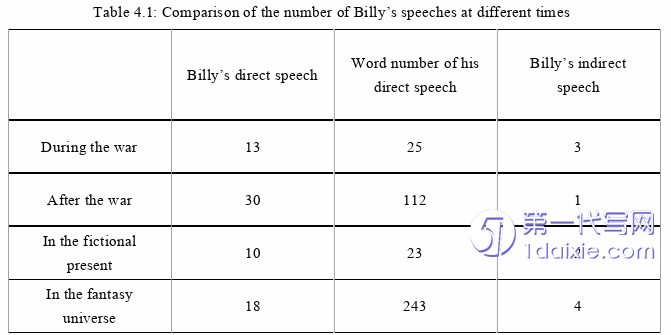本文是一篇英语论文,本文验证了在结构形式层面上叙述学和文体学结合的可行性,以叙事技巧作为宏观框架和出发点,从微观上探寻语言特征,从而更深入、全面地阐释小说的主题意义和美学效果。
Chapter One Introduction
1.1 Research background
Kurt Vonnegut (1922-2007), was an American pacifist writer, and one of the representatives of American black humor literature. He was praised by Graham Greene, an English famous writer, and journalist as “the most talented writer in America today”. Published in 1969, Slaughterhouse-Five was one of Vonnegut’s best-known novels with multiple viewpoints, profound themes, and postmodern techniques. Slaughterhouse-Five was so highly valued by writers and critics in our country and in other countries since its publication that it was nominated the Hugo Award. It tells the story of Billy Pilgrim, a former American soldier in the Second World War who was a prisoner of war (POW) in Dresden, Germany. What he suffered was the inhumane treatment by the German soldiers and the horrifying bombing scene in Dresden.
As an anti-war activist, Vonnegut aims to save humankind and arouse people’s anti-war sentiment by writing fictions. It can be found that his writing purpose has been realized in Slaughterhouse-Five, which reflects his own war experience and anti-war appeal through deconstruction and reconstruction with its successful narrative skills. There are plenty of analyses of the novel from the perspective of narrative skills and themes; however, there are relatively few interpretations of the themes combining both narrative techniques and linguistic features. These techniques consciously reveal the detestation of war and the desperation for survival, reinforcing the representation of the loss of humanity, the hatred of war, and the eagerness to escape from the indifferent society.
1.2 Purpose and significance of the study
Vonnegut, who is regarded as a writer of science fiction, has a great influence on the writing of later generations. His writing style can be seen through the themes of his works, including abhorrence of war, despair of reality, and satire of the current government and politics. His superb writing level is demonstrated by his writing skills, such as the fragmentation of narrative time and space, well-arranged plots and characters, and wisely-chosen discourses. Therefore, it is worth studying Vonnegut’s novels.
It is worth noting that Slaughterhouse-Five is a masterpiece that the author spent twenty-three years recollecting his experience in World War II. Analyzing the techniques is a better approach to comprehending the author’s ideology behind the texts. There is a fact that most researchers are interested in the story instead of viewing the novel comprehensively in narratology and style, which shows a research gap. As such, the non-linear narrative and drastic change of the narrative order portrayed a veteran with mental disorders caused by the war. It also contains changes of perspective because the events are portrayed through the author’s omniscient narrator, who tells Billy’s story and Billy’s account of his story in Dresden. All in all, the well-designed, conscious representation of reality can be ascribed to delicate storytelling and word choice. Therefore, it is important to study literary text under narrative stylistics.
Chapter Two Literature Review
2.1 Previous studies on narrative stylistics

Numerous scholars currently combine narratology and stylistics to produce a new literary interpretation. Building on Chatman’s work, we could say that whereas style deals with the form of narratives (verbal nuances, for example), narrative form refers to the broader and more abstract devices that not only organize the fictional text but are also more explicitly tied to its thematics (Lothe, 1989, p. 9). Lothe’s distinction between stylistics and narratology is critical to the point. Narratology and stylistics both investigate the level of forms, although they have different emphases. The narratologist is concerned with the relationship between events on the tale level and their reordering on the discourse level. The stylistics, on the other hand, focuses on specific linguistic features that are foregrounded to increase the thematic and aesthetic effects. Many scholars have recognized the need to bring them together. Following that, we will look at their multidisciplinary research from two perspectives.
2.2 Previous studies of Slaughterhouse-Five
After searching on CNKI and google scholar with the keyword of Slaughterhouse-Five, it is found that the literary studies of the novel are abundant, with the evidence of 376 journal papers and 113 master’s theses. Previous studies on Slaughterhouse-Five are mainly from the perspectives of themes, narrative techniques, and linguistic features.
The researches abroad on the themes of Slaughterhouse-Five are as fruitful as at home. No one has better illustrated Vonnegut’s thoughts in writing of Slaughterhouse-Five in the 1970s than Merrill and Scholl (1978), who correct the misunderstandings about the previous critiques of Slaughterhouse-Five, pointing out “harmless untruth” and “insoluble problems” are the normality of human beings. Babaee et al. (2014) expound on the dystopian theme of Slaughterhouse-Five, considering the aim of writing the novel was to build a dystopian society without enslavement, control, and aggression. Critics, including McGinnis (1975), Miller (2015) and Singh (2010), have a unanimous thought that Vonnegut’s Slaughterhouse-Five aims at inciting anti-war sentiment and building death themes. Diwany (2014) suggests the uncertainty of postmodernism and emphasizes that Vonnegut endeavored to reveal the instability and contradictions of postmodern society, full of an imbalance of reality and fantasy. Louis (2017) notes that the values embodied in the novel are the characteristics of materialism. Thus, it can be seen that the themes of Slaughterhouse-Five are so complex that many scholars have different perspectives, but this is also the reason why the novel is controversial and attractive to people.
Chapter Three Theoretical Framework ......................... 11
3.1 General introduction to narrative stylistics ................................... 11
3.2 Narrative Time ................................... 13
Chapter Four Narrative Stylistic Analysis of Slaughterhouse-Five ...................... 20
4.1 Narrative time in Slaughterhouse-Five ..................................... 20
4.1.1 Temporal order ......................................... 20
4.1.2 Frequency ............................................ 26
Chapter Five Conclusion .................................. 48
5.1 Major findings of the study ....................................... 48
5.2 Limitations and suggestions for future research ............................................. 49
Chapter Four Narrative Stylistic Analysis of Slaughterhouse-Five
4.1 Narrative time in Slaughterhouse-Five
The subchapter focuses on examining the narrative techniques and linguistic features of the narrative time. The manipulation of narrative time makes the narrative text inconsistent and disordered. This section focuses on analyzing the narrative techniques of temporal order and frequency and their related linguistic features in Slaughterhouse-Five.
4.1.1 Temporal order
According to Genette, the conception of temporal order contains two kinds: the order of succession of the story, and the arrangement in the narrative (1980, p. 35). If the narrative time matches with the story time, the chronological order is created. However, fiction writers manipulate the order of story time instead of following the order of the sequence of the story. Genette names this narrative technique anachrony (1980, p. 35). This thesis will focus on the anachronical technique adopted in Slaughterhouse-Five.

Chapter Five Conclusion
5.1 Major findings of the study
First, the narrative stylistic approaches to each structural technique are combined closely. Using the three structural elements as a starting point, the general procedure that follows in our examples is from describing and interpreting narratological techniques that work as the framework for the subsequent stylistic analysis, which in turn specifies, completes the former to the final interpretation of the theme and the author’s unique perception of the contemporary world.
Second, the analysis of the narrative techniques and linguistic features reveal the themes in Slaughterhouse-Five. The distorted temporal order with the combination of speeches from different registers makes the readers perceive the novel as fragmented. The repetitive narrative and tone of irony create a sense of despair, building a chaotic and desperate theme.
The narrative stylistic interpretation of the character gives the readers an image of Billy, who is vulnerable, avoidant, pessimistic, and insane. It shows that the character has been tortured by the war mentally and physically. Opposite to the normal protagonist in the fiction, which helps build the anti-hero theme.
reference(omitted)
